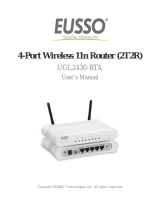
MWN-WAPR150N Wireless Router v11.8
6.5 WDS SETTINGS – BRIDGE/REPEATER .................................. 83
6.6 WIRELESS ACCESS CONTROL (MAC FILTER) ....................... 86
6.7 CONNECTION STATUS ........................................................... 86
CHAPTER 7 DHCP SERVER ................................................... 88
7.1 DHCP SETTINGS .................................................................. 88
7.2 DHCP LIST AND BINDING .................................................... 89
CHAPTER 8 VIRTUAL SERVER ............................................ 90
8.1 PORT RANGE FORWARDING .................................................. 90
8.2 DMZ SETTINGS – GAMING/VIDEOCONFERENCING ................ 91
8.3 UPNP SETTINGS .................................................................. 92
CHAPTER 9 TRAFFIC CONTROL ......................................... 94
9.1 TRAFFIC CONTROL ............................................................... 94
CHAPTER 10 SECURITY SETTINGS .................................... 96
10.1 CLIENT FILTER SETTINGS ................................................... 96
10.2 URL FILTER SETTINGS – WEBSITE BLOCKING ................... 97
10.3 MAC ADDRESS FILTER – PARENTAL CONTROL .................. 99
10.4 PREVENT NETWORK ATTACK - FIREWALL ........................ 100
10.5 REMOTE WEB MANAGEMENT .......................................... 101
10.6 WAN PING ....................................................................... 102
CHAPTER 11 ROUTING SETTING ...................................... 104
11.1 ROUTING TABLE ............................................................... 104
CHAPTER 12 SYSTEM TOOLS ............................................ 105
12.1 TIME SETTINGS ................................................................ 105
12.2 DDNS .............................................................................. 106
12.3 BACKUP/RESTORE SETTINGS ........................................... 107
12.4 RESTORE TO FACTORY DEFAULT SETTING ........................ 109
12.5 UPGRADE FIRMWARE ....................................................... 110
12.6 REBOOT THE ROUTER ........................................................111
12.7 PASSWORD CHANGE ..........................................................111
12.8 SYSTEM LOG .................................................................... 113






















